Google’s May 2022 broad core update rolled out on May 25, 2022 and the rollout completed on June 9, 2022 (taking about 15 days to fully roll out). It was a massive algorithm update with many sites seeing a ton of volatility early in the rollout. But that was just the beginning, as we saw several large tremors during the rollout (with some sites reversing course based on those adjustments). I’ll cover more about tremors later in this post.
Also, it really felt like there was something different with this update (based on analyzing sites getting rewarded, sites surging back from the dead, the tremors that rolled out, the intent shifts that occurred, etc.) It was one of the biggest updates I have seen in a long time.
The problem is that we’ll never know what Google changed. That’s the reality of where we are with broad core updates, and it’s extremely important to understand that. I’ll also cover more about this later in my post.
Broad Core Update Case Studies:
When covering broad core updates, I’ve found the most effective way to demonstrate what happened is to provide cases of sites I have worked on. That’s because I have in-depth knowledge of each site, their history, each niche overall, I know what was surfaced during the audits, the work that was completed, how long those changes have been in place, and more. So, I’m going to cover five micro-case studies that once again underscore the complexity of broad core updates. In addition, I’ll cover some other important changes that coincided with the May 2022 broad core update.
Here is a quick table of contents in case you want to jump around:
- The May Update – Something seemed different.
- A reminder about machine learning and tremors.
- Interesting Finds goes missing.
- Case 1: Financial site surges (YMYL with UGC)
- Case 2: e-commerce site drops (but only fringe blog content)
- Case 3: Health and medical site surges (with heavy UGC)
- Case 4: Entertainment community site drops – games, and more.
- Case 5: Review site heavily impacted by broad core update tremor.
- Notes about quality, site-level quality algorithms, and more.
- Key points for site owners.
The May 2022 Broad Core Update – Something seemed different, but we’ll never know what changed.
Again, something just felt different with this update. It was huge, with a ton of volatility, several powerful tremors that had sites reversing course, and the extreme swings in search visibility (especially across certain YMYL categories) had me believing that Google implemented something new (and big). I believe they did, but once again, we will never know for sure what was changed. Broad core updates are extremely complex and take many factors into account, and over a long period of time. I’ll cover more about this soon.
There were also many sites (especially in YMYL) surging back from previous core update drops when they did nothing (or little) overall to improve. Yes, you can always see that during broad core updates, but this update seemed to yield more of those reversals/recoveries than others… And the massive swings back make me think the change could be more on Google’s end than the actual sites doing anything.
Here are two examples of this happening:


That’s a good segue to a reminder about how machine learning might be used with broad core updates.
A reminder about machine learning systems and broad core updates… Potentially thousands of signals sent to a machine learning system.
I have covered this a number of times in my posts and presentations about broad core updates, and it’s extremely important to understand. Google is doing a ton of evaluation over a long period of time with broad core updates. And from a machine learning standpoint, Google could be sending many signals to the machine learning system, where the system determines weighting of those factors, and ultimately rankings.
Bing is much more transparent about its use of machine learning for its core ranking algorithm. Bing’s Fabrice Canel explained that not even search engineers could go in and determine how powerful certain factors were. He explained they send thousands of factors to the machine learning system, which determines weighting, and then rankings.
The reason I bring this up (again) is because you will not be able to break down all of the factors being evaluated by Google with broad core updates, the weighting of those factors, etc. And over time, Google could always be sending more signals to the machine learning system (making the system even more sophisticated as it needs to determine weighting of those new signals, which again, can impact rankings). Any change there could cause sites to surge when they shouldn’t, come back from the dead when they did nothing, or cause sites to drop that were once doing well.
The tremors we saw with the May 2022 broad core update signal to me (pun intended) that the initial rollout was not as successful as Google wanted. Several tremors were needed in order to get the results where Google wanted them.
Regarding tremors, John Mueller once explained that Google can always implement tweaks and adjustments after a major update rolls out. Well, we saw some sites completely tank ten days into the rollout and then surge back after the rollout was complete. I’ll cover more about that later, but that does give us a partial view into how Google needed to implement some big tweaks to get things in order. So, to reiterate what I include in every presentation about broad core updates, “Welcome To Google Land”.
An “Interesting” Removal: Google’s “Interesting Finds” Mobile SERP Feature Goes Missing, Right Around The May Core Update
This is important to understand since it could also impact traffic for many sites across the web (and heavily for some sites). As I was analyzing client sites after the May broad core update rolled out, I noticed that Google’s Interesting Finds SERP feature went missing. That’s a big deal, since it was a large mobile SERP feature providing three articles by default in the module, that linked to a full listing of 20+ articles. Also, Interesting Finds enabled sites to double dip in the search results (the same article could rank in the module and in the 10 blue links all within page one of the search results).
Here is what Interesting Finds looked like in the mobile SERPs:
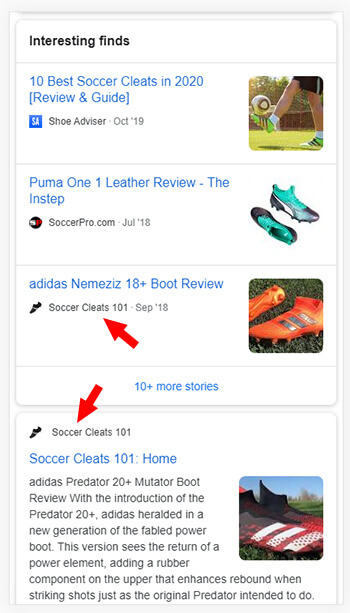
It looks like the feature was removed right as the May broad core update rolled out, which is interesting timing (pun intended). So, if you saw a drop in traffic with the update, definitely check out the SERPs for the queries where your site dropped. If you were ranking in Interesting Finds, that could be another factor contributing to the drop.
I have theories about why Interesting Finds was removed, and it could be related to the new visual SERP features that have hit the scene recently. For example, larger visuals, more video, the new grid layout, short videos, etc. You can check my post that covers a number of new features being tested or that have rolled out recently. That’s based on my presentation at the Google SEO Meetup in NYC in June.
Now let’s move to the cases!
5 Micro-cases: Surges and Drops from the May 2022 Broad Core Update
As I mentioned earlier, I’ll provide five micro-cases below that underscore the complexity of broad core updates. Each is unique and I’ll cover both drops and surges. Let’s jump in.
Case 1: YMYL Site surges (financial) – Recovery during a smaller core update and more with the May 2022 broad core update.
This is a large and complex site in the financial vertical. It’s an international site that contains a good amount of user-generated content (UGC). The site had seen its fair share of drops and surges during previous broad core updates and had dropped pretty heavily during the June 2021 broad core update. That’s after major volatility during previous core updates. The site owner was tired of the uncertainty and wanted to tackle the situation full-blast.
Here is the drop from the June 2021 core update:
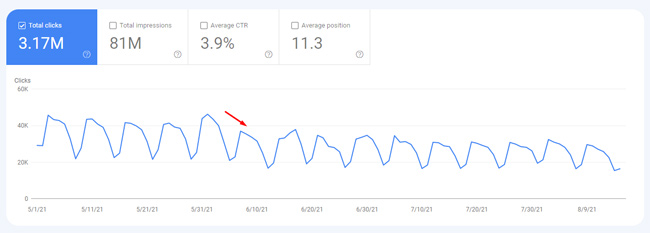
During the crawl analysis and audit, I surfaced many problems across the site from “quality indexing” problems to thin content to lower-quality UGC to technical problems causing quality problems. In addition, E-A-T is super important based on the vertical and there were gaps from an authority standpoint. Remember, E-A-T is heavily influenced by links and mentions from authoritative sites (off-site factors versus on-site). But it’s also important to reinforce your expertise by taking care of on-site factors (which they also needed to address).
The site owner worked hard to rectify as many of the issues as they could, which took a good amount of time (based on the sheer amount of issues plus a smaller development and content team to tackle the problems). And again, it’s a large-scale site with many moving parts, so any change could impact tens of thousands of pages (or more).
The November broad core update rolled out and the site was steady (but it was still down). The good news is that it didn’t drop more, but it needed more time in my opinion. That’s because all of the changes weren’t implemented yet and we know that Google needs to evaluate those changes over the long-term.
And then February 2022 arrived with a bang.
What looked like a smaller core update rolled out in early February 2022, and the site surged like mad. It’s a good reminder that Google pushes smaller core updates all of the time, and some can have a profound effect on visibility for certain sites. They aren’t broad updates that impact many sites across the web… but they can have a big impact for specific sites (if those smaller changes impact those sites…) The site surged by 39% that day and remained up from that time on.
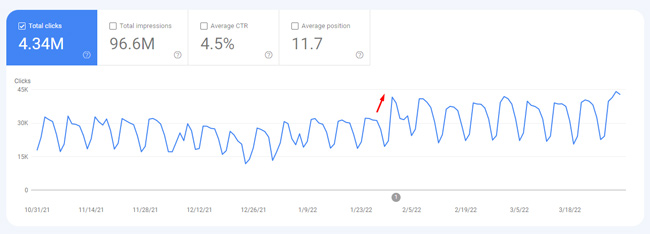
And regarding smaller core updates, Google explained this right in their post about broad core updates. But I think many look past that point since they are focused just on broad core updates.
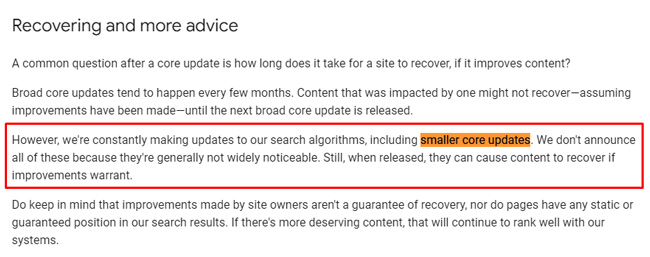
But the increase wasn’t done yet. When the May 2022 broad core update rolled out, they increased even more. So between the February 2022 smaller core update and the May 2022 broad core update, the site is in much better shape now visibility-wise and traffic-wise. And, they have fixed a number of issues across the site that will hopefully limit volatility during future broad core updates.
Here are several examples of urls surging with the May update. Notice one is during the 6/5 tremor (which I’ll cover later in this post).
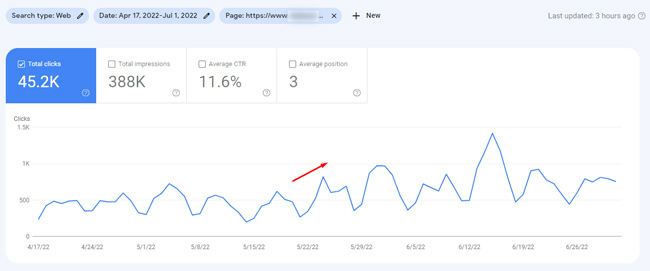
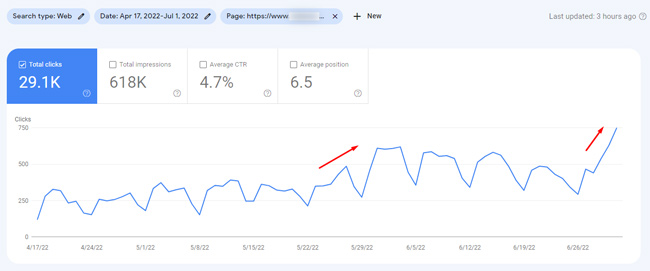
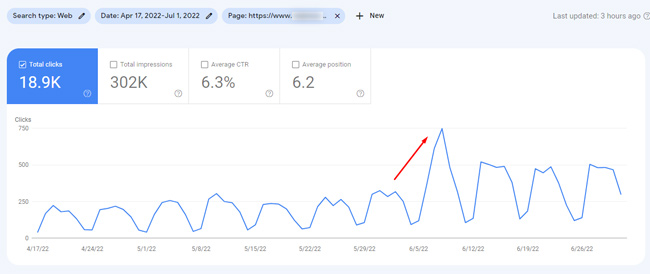
Case 2: e-commerce site drops, but only blog content “out of their lane”
This e-commerce site produces a lot of informational content and has over a long period of time. And some of that content isn’t ultra-focused on the core competency of the company. There is a core e-commerce part of the site and then a lot of article content that some would be considered “fringe” in my opinion. It’s not core to the site, but is tangentially related to what the site sells. It’s definitely high-quality content, but topically it’s sort of “out of their lane”.
That content has historically ranked well (even winning a number of featured snippets over time), but I always brought up the possibility of that content dropping (just because other, more authoritative sites for those topics could potentially outrank this e-commerce site). In other words, there could be a relevancy adjustment that adjusts rankings for that content, or Google could decide that another type of site should rank for those queries (intent shift).
Well, the May 2022 broad core update rolled out, and boom, that content took a hit. When analyzing that informational content versus the core e-commerce site content, the data revealed the e-commerce portion didn’t drop at all. So, Google’s algorithms adjusted rankings for the blog content while the core e-commerce part was fine visibility-wise. In addition, the site owner explained that year over year, the e-commerce portion of the site is up traffic-wise (and conversions are steady).
Here is the fringe blog content that dropped wit the May update:

And here is the core, e-commerce part of the site (stable):
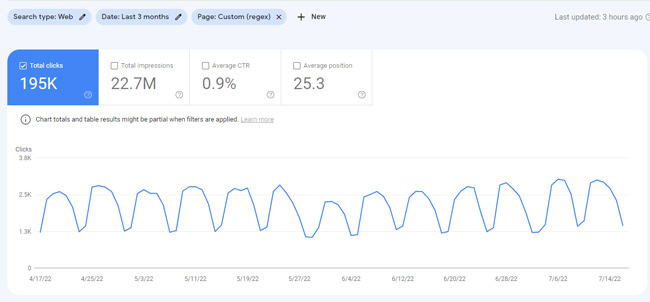
In my opinion, the change does make sense. It’s also why I’m a big fan of making sure your content generation plan heavily targets your core users. I have always recommended “staying in your lane” from a content standpoint. This case is a good example why.
Case 3: Health and Medical Site Surges – With Heavy UGC
This is a large-scale site focused on health and medical with a lot of user-generated content (UGC). It has also surged and dropped over time during broad core updates, and dropped during two subsequent broad core updates recently (June 2021 and November 2021).
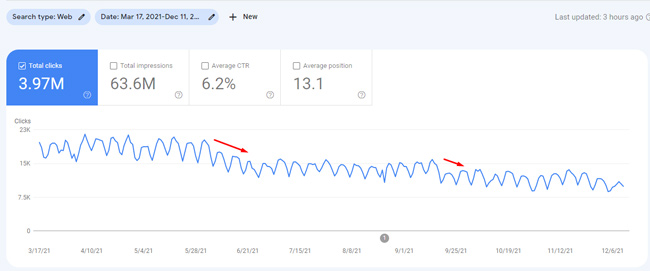
I just started helping the site in May 2022 so I was not involved in the changes that were implemented prior to then (but after reviewing the changes that were completed over the past several years, I would agree on several of those bigger changes). There are definitely some I wouldn’t agree with, but there were several significant changes that I think could have made a big difference quality-wise.
For example, they heavily worked on improving “quality indexing”, making sure low-quality or thin content wasn’t indexed, while ensuring their highest quality content is indexed. They nuked thousands of urls over the past year or two and focused on making sure the pages that were indexed provided high quality and relevant information to users. They also improved on-site E-A-T by making sure experts wrote and/or reviewed content on the site, highlighting those experts, providing references and citations, and also using structured data to reinforce the health and medical content. Structured data is not a ranking factor, but it can give Google more context related to the content. That’s not all they did (there is a huge document with all the changes), but those are some of the core changes.
Well, the site surged during the May 2022 broad core update. The site is up 29% since the update rolled out and has held steady (even through the tremors that followed the initial update).
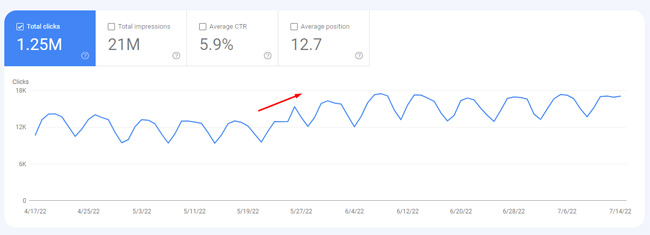
After reviewing the surge, the content that increased rankings-wise, and the changes that were implemented, I believe the surge is probably based on a combination of things. For example, the surge could be due to the work that has been completed to improve the site, maybe Google pushing UGC more for the queries versus informational sites (intent shifts), and possibly Google just turning the dials from a machine learning system standpoint.
From an intent shift standpoint, Google’s algorithms might now believe users want to hear from real people (mixed with expert responses) over article-based content. That’s at least for now… Intent shifts can be tricky and can turn on a dime. It’s impossible to say for sure, but UGC definitely jumped up in their market.
On that note, this is an international site and I’m not seeing the same type of content rank for English queries here in the US. When Google pushes UGC, that’s more of an intent shift. The site did complete a lot of work to improve, which is outstanding, but it’s hard to say how much of the surge is due to that. So, time will tell if the surge remains. For example, if Google pushes another intent shift, the site could drop (since it heavily contains UGC). They continue to work on improving the site, so we are all hopeful those changes can limit volatility over the long-term.
Case 4: Entertainment community site – games and more.
The site is a large-scale and complex one (with a long history). It has seen its fair share of ups and downs with broad core updates over time. During the crawl analysis and audit, I uncovered many issues that could be impacting quality overall for the site.
For example, there were many technical problems that could be impacting quality, there was a large thin content issue across the site (just based on the sheer amount of content on the site), the overall design and UX needed to be updated (it was looking older and dated), there was a ton of duplication based on the nature of the site, and more.
The site owner worked very quickly to implement changes and they completed a lot of work to improve the site. But, there is still more to tackle IMO on several levels. The site owner knows this and continues to work on improving the site overall.
After some work was implemented that impacted many pages across the site, rankings did jump for some important head terms in fall of 2021 (like the most important term based on what the site focuses on). That was super-interesting to see and it was outside of a broad core update. The site overall didn’t surge then, but certain important terms did spike in rankings. So again, that could be have been based on a smaller core update, which again, Google releases all the time.
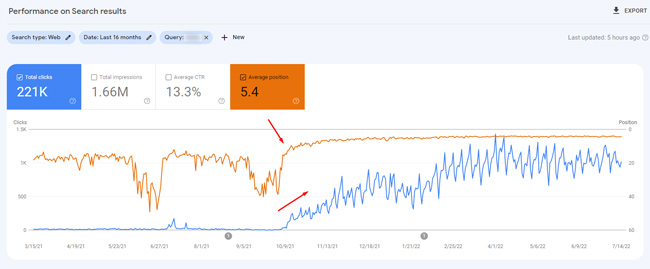
And here is a combination (via regex) of three important head terms that surged at that time:

The site was stable through the November 2021 core update, which was a win based on dropping with the June 2021 update and bigger changes not being in place for a very long time yet. But then the May update rolled out and it wasn’t great for the site traffic-wise. It dropped by 18%. But as I’ve always said, it’s important to run a delta report to understand what dropped, and why.
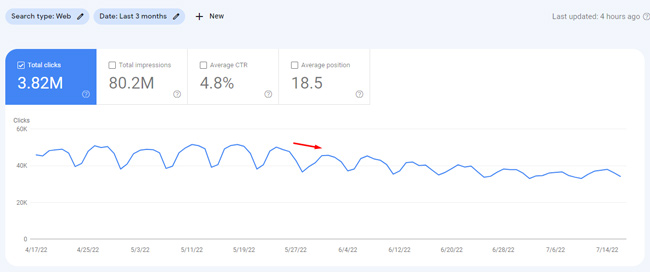
Running a delta report based on the May core update drop revealed a number of relevancy adjustments. When objectively reviewing those drops, they did make sense. For example, ranking for entity names when the site just had games related to those entities. When you add qualifiers to the query that related to what the site offers content-wise, the site still ranks very well.
For example, here are two core query categories remaining stable throughout the update:
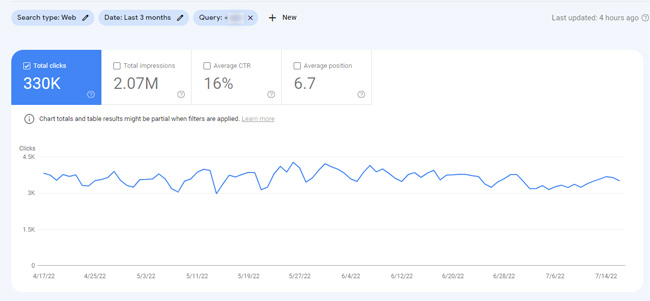
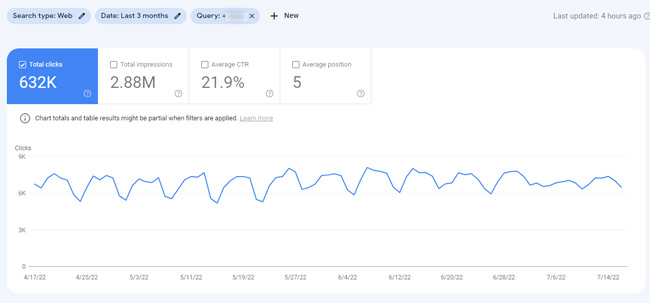
Now the tough news. When the site did drop for important queries, it was often outranked by major publishers that aren’t directly focused on entertainment, games, etc. This irks the site owner to no end (and I totally understand that). This is something I have heard from many site owners over the years. Large powerful publishers creeping into their niche with a new section of content (or subdomain). Clearly that’s a tough situation if you’re competing with major publishers with tens of millions of links, extremely strong E-A-T, etc. But, this site focuses entirely on the niche and has for many years.
Here is a good example where larger publishers started outranking the site on page one. This site still ranks around the middle of page one, but you can clearly see the drop with the May broad core update.
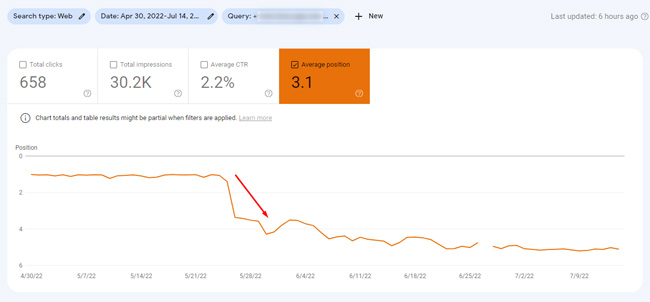
So for this site, it’s a mix of relevancy adjustments and then larger, more authoritative sites outranking them for certain queries (even when those publishers don’t really focus on the niche). The site still ranks very well for many queries (and a number of important ones related to the content), but the update was not good for them overall. We’ll see if this gets adjusted over time as Google’s algorithms learn if users are happy with the results, which sites and content helps them the most, etc.
Case 5: Broad core update tremor that destroyed, and then revived, a product reviews site.
At the Google Webmaster Conference in 2019, Google’s Paul Haahr (a lead ranking engineer) explained that Google can always decouple algorithms from broad core updates and run them separately. That was fascinating to hear, and I’m confident we have seen that happen a number of times since then. It’s super important for site owners to understand this and I wanted to provide an example of this in action below (at least I believe it’s what happened AFTER the May 2022 broad core update officially rolled out).

One of my clients started seeing a nice increase during the May 2022 broad core update. It’s a reviews site that has surged and dropped with several Product Reviews updates. So it was good to see movement in the right direction… But then the 6/5 tremor rolled out. And that tremor was big for a number of sites that were impacted by the May core update. For this client (and for other sites), they dropped heavily on 6/5. And when I say heavily, I mean HEAVILY. As my client explained, they didn’t just drop from page one to page two. It was hard to find the site ranking at all for those queries (even in the top 100).
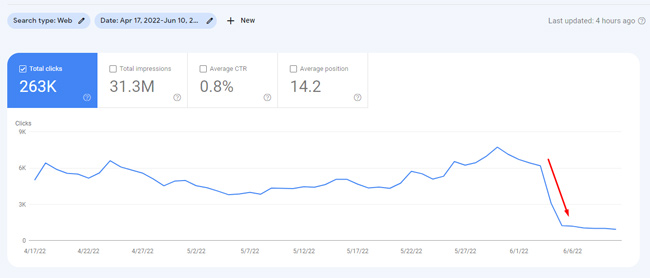
After this happened, I truly believed Google would correct that mistake before the update fully rolled out. But that wasn’t the case… Google announced the update had completed on June 9th . That was scary as heck for my client… Would they really remain down that much? In my opinion, they absolutely shouldn’t have dropped like that.
Well, another unconfirmed update rolled out on 6/12 (just three days later) and a number of those sites that dropped during the 6/5 tremor roared back. It was crazy to see… So, did the broad core update really complete before then? Or was this the decoupling of an algorithm (or several) from broad core updates and Google running them separately? Hard to say, but it’s important to understand this can happen with major updates… Check out the trending below.
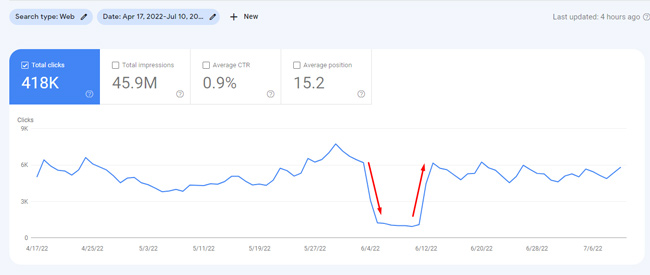
Final Notes: Google trying to surface the highest quality and most relevant sites and content, quality is more than just text on the page, and the importance of Google’s site-level quality algorithms:
As you can see from just the five cases above, it’s extremely hard to understand exactly why some sites surge and others drop. Broad core updates are complex and can yield relevancy adjustments, intent shifts, or drops based on overall quality issues.
Again, nobody is going to reverse engineer broad core algorithm updates. Google’s Danny Sullivan recently explained at the Google Meetup in NYC that Google is truly attempting to reward great content (and great sites) with broad core updates.
But, it’s clearly way more complicated than just writing great content, although I get what he’s trying to say. And add that John Mueller has explained that “quality” is more than just the content on the page. That could mean the layout, ads on the page, user experience, etc. That’s why it’s important to focus on improving your site overall versus cherry picking changes. And like John explained, don’t just focus on the text on the page… it’s more than that.
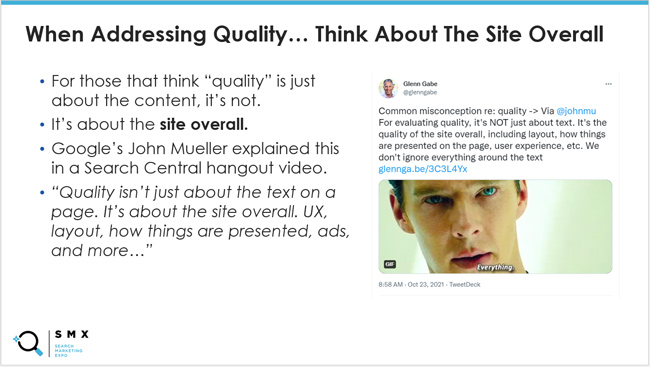
We also know that Google’s site-level quality algorithms can have a big impact on websites during broad core updates, and that has little to do with what’s going on at the query level. So don’t miss the forest for the trees by just checking specific queries for a site that surge or drop. It could be a much bigger problem overall quality-wise. Work on improving your site overall from content to UX to the advertising situation to technical SEO causing quality problems and more. That’s what I call the “kitchen sink” approach to remediation.
Here is just one of my tweets (of many) about this with a link to a video from Google’s John Mueller discussing the topic. Do not overlook this point. It’s super-important.
The May 2022 Broad Core Update: Key points for site owners:
- The update just felt different, but we’ll never know what specifically changed. There was more volatility, bigger swings, etc. during the May update. There were also several large tremors during the rollout.
- Machine learning could make it nearly impossible to reverse engineer what Google is doing. Google can be sending thousands of factors to the machine learning system, which determines weighting, and then rankings. Bing has explained that search engineers can’t even go in and determine the weighting of various factors.
- Google can roll out smaller core updates that can have a big impact on your site’s visibility. Those updates might not have a big impact on the web overall, but they can sure move the needle for specific sites (if those smaller core updates impact the site).
- Intent shifts can cause sites to surge or drop (and site owners have no control over that). That’s when Google ranks a different type of site for the query.
- Relevancy adjustments can also have a big impact, but they might be totally correct. Objectively review your drops after running a delta report. Make sure your content is the most relevant for the query at hand.
- Overall site quality can also impact sites during broad core updates. If that’s the case, then working to significantly improve your site over time is the best path forward. “Quality” is more than just the textual content on the page. So work on improving the user experience, ad situation, layout, and more (beyond just improving content quality).
- And finally, Google could always decouple algorithms from broad core updates and run them separately (and you can end up surging back when that happens as well). And that wouldn’t be during a broad core update. Again, Welcome to Google Land.
Summary: The May 2022 Broad Core Update Was Huge…
I hope the case studies I covered helped you understand more about broad core updates and how complex they can be. Google is evaluating many factors over a long period of time with broad core updates, and sites can see massive volatility in search visibility when the updates roll out. If you were impacted by the May 2022 update, I highly recommend running a delta report and identifying the top queries and landing pages that dropped. Then determine if it was a relevancy adjustment, intent shift, or it’s overall site quality problems that’s dragging the site down.
And definitely make sure to review the SERPs to understand various features and treatments that could be impacting visibility and click-through rate. All of this can contribute to traffic volatility.
Until the next broad core update, good luck.
GG
Original Source: The Google May 2022 Broad Core Update – 5 micro-case studies that once again underscore the complexity of broad core algorithm updates
